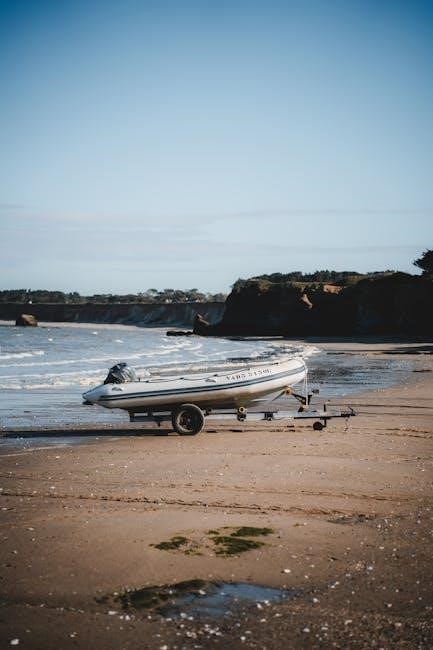Boat trailer guides are essential accessories that assist in aligning and centering your boat on the trailer during loading and unloading, ensuring smooth and precise maneuvering.
What Are Boat Trailer Guides?
Boat trailer guides are accessories designed to assist in aligning and centering a boat on its trailer during loading and unloading. They are typically attached to the trailer frame and extend outward, providing visual markers or physical supports to help guide the boat into the correct position. These guides can be made of materials like galvanized steel, aluminum, or PVC and come in various styles, such as bunk, post, or roller designs. Their primary purpose is to simplify the process of loading and unloading, especially in challenging conditions like windy days or low-visibility environments. By enhancing precision and stability, boat trailer guides help ensure safe and efficient trailer operations. They are an essential tool for boat owners seeking to streamline their boating experiences.
Why Are Boat Trailer Guides Important?
Boat trailer guides are crucial for ensuring safe and efficient boat loading and unloading. They provide clear visual cues, helping to center the boat on the trailer, which reduces the risk of damage to both the boat and the trailer. Guides also enhance stability, particularly in windy or rough conditions, making the process less stressful for boat owners. Additionally, they save time by streamlining the alignment process, allowing for quicker launches and retrievals. Their importance extends to protecting the boat’s hull from scratches or dings that can occur during misalignment. Overall, boat trailer guides are a vital accessory for maintaining the integrity of your boat and trailer while improving the overall boating experience.
Benefits of Using Boat Trailer Guides
Using boat trailer guides offers numerous benefits, enhancing both safety and efficiency. They simplify the process of loading and unloading by providing clear visual markers, reducing the risk of misalignment. This not only protects the boat from damage but also prevents wear and tear on the trailer. Guides minimize the strain of maneuvering in challenging conditions, such as strong winds or low visibility, making the process less stressful. Additionally, they save valuable time, allowing for quicker launches and retrievals. Durable materials, like galvanized steel or PVC, ensure long-lasting performance in harsh marine environments. By improving alignment accuracy and reducing the likelihood of accidents, boat trailer guides are an indispensable tool for boat owners, ensuring a smoother and more enjoyable boating experience.
Types of Boat Trailer Guides
Boat trailer guides come in three main types: bunk-style, post-style, and roller-style, each designed for different boat sizes and trailer setups, ensuring proper alignment and support.
Bunk-Style Trailer Guides
Bunk-style trailer guides feature carpeted or padded surfaces that cradle the boat’s hull, providing excellent support during loading and unloading. These guides are ideal for boats with a flat bottom or those requiring extra stability. They are mounted directly onto the trailer’s frame and can be adjusted to fit the boat’s width. The soft surfaces protect the boat from scratches and abrasions, while the sturdy construction ensures durability. Bunk-style guides are popular among anglers and recreational boaters, offering a reliable solution for safe and efficient trailer alignment. Their simple design makes them easy to install and maintain, ensuring a smooth boating experience every time.
Post-Style Trailer Guides
Post-style trailer guides are vertical or angled poles that extend from the trailer frame, providing a visual and physical reference for aligning the boat during loading. Made from durable materials like galvanized steel or aluminum, these guides are rust-resistant and built to withstand harsh marine environments; They often feature PVC or rubber caps for added protection and visibility. Adjustable models allow customization to fit various boat sizes and trailer configurations. Post-style guides are easy to install and offer a cost-effective solution for improving loading accuracy. They are particularly useful in low-light conditions or when launching in windy or choppy waters, ensuring a safer and more efficient experience for boat owners of all skill levels.
Roller-Style Trailer Guides
Roller-style trailer guides feature smooth, cylindrical rollers that gently guide the boat onto the trailer, reducing friction and minimizing the risk of damage to the hull. These guides are particularly advantageous for larger boats or those with sleek hull designs, as they allow for easier centering and alignment. Constructed from durable materials like galvanized steel or aluminum, roller-style guides are both rust-resistant and long-lasting. They are often adjustable, enabling customization to fit various boat sizes and trailer setups. By providing a cushioned surface, roller-style guides enhance the loading process, making it smoother and less labor-intensive, while also protecting the boat’s finish from abrasions. This makes them a popular choice among boat owners seeking a low-maintenance, efficient solution for trailer alignment.

Materials and Construction
Boat trailer guides are crafted from durable materials like galvanized steel, aluminum, and PVC, ensuring resistance to corrosion and wear in marine environments. These materials provide strength and longevity, withstanding harsh conditions while maintaining functionality. The construction often includes adjustable features, allowing for customization to fit various boat sizes and trailer setups. By utilizing rustproof finishes and robust designs, these guides ensure reliable performance and protect your boat during loading and unloading. The combination of quality materials and sturdy construction makes them a vital component for safe and efficient boat handling, enhancing overall trailer reliability and user satisfaction. This ensures your boat remains securely aligned and well-protected.
Galvanized Steel Trailer Guides
Galvanized steel trailer guides are a popular choice due to their exceptional durability and rust resistance. They are constructed with heavy-duty galvanized steel, ensuring long-lasting performance in harsh marine environments. These guides are designed to withstand saltwater, moisture, and UV exposure, making them ideal for frequent use. Many models feature adjustable designs, allowing users to customize the fit for their specific boat and trailer setup. Brands like JY PERFORMANCE offer rustproof electro-galvanized steel options with PVC pipes for added protection. These guides are easy to install and provide reliable support during loading and unloading. Their robust construction ensures they remain stable and secure, even in challenging conditions. With their durability and versatility, galvanized steel trailer guides are a practical investment for boat owners. They are widely available, with options like the JY PERFORMANCE model priced at $63.99 on product pages, making them an affordable and reliable choice for enhancing trailer functionality and safety.
Aluminum Trailer Guides
Aluminum trailer guides are a lightweight yet durable option, offering excellent corrosion resistance in marine environments. They are naturally rust-proof and require minimal maintenance. These guides are ideal for boat owners seeking a balance between strength and ease of handling. Aluminum guides are often adjustable, allowing precise alignment with various boat sizes and trailer setups. Their lightweight design makes them easier to maneuver, reducing strain during loading and unloading. Despite their lower weight, they remain robust and capable of withstanding regular use. Aluminum trailer guides are a cost-effective choice, providing long-term reliability and performance. They are widely available in adjustable and fixed models, catering to different boating needs and preferences, making them a practical and efficient solution for trailer guidance systems.
PVC and Composite Trailer Guides
PVC and composite trailer guides offer exceptional durability and resistance to marine environments, making them ideal for boat owners seeking low-maintenance solutions. These guides are designed to provide clear visibility, even when submerged, aiding in precise alignment during loading and unloading. Their smooth, non-abrasive surfaces protect the boat’s hull from scratches and damage. PVC guides are lightweight, corrosion-proof, and easy to clean, ensuring long-lasting performance. Composite materials combine strength with flexibility, offering robust support while absorbing minor impacts. These guides are often adjustable, allowing customization to fit various boat sizes and trailer configurations. Their bright colors enhance visibility, making them a practical and stylish choice for boat owners prioritizing convenience and durability.
Adjustable vs. Fixed Trailer Guides
Adjustable trailer guides offer versatility, accommodating different boat sizes and trailer setups, while fixed guides provide stable, permanent alignment solutions for consistent loading and unloading efficiency.
Adjustable Trailer Guides
Adjustable trailer guides are highly versatile, accommodating various boat sizes and trailer setups. These guides feature adjustable height and width settings, ensuring proper alignment for different vessels. Made from durable materials like rustproof galvanized steel, they often include PVC pipes for enhanced visibility. Their adaptability makes them ideal for boat owners who need flexibility. Installation is straightforward, with mounting hardware kits available for secure attachment. Adjustable guides simplify the loading and unloading process, reducing alignment challenges. They are especially useful for trailers that need to accommodate multiple boat types or sizes. This feature enhances efficiency and safety, making them a practical choice for many boating enthusiasts.
Fixed Trailer Guides
Fixed trailer guides provide a permanent solution for boat alignment, offering stability and consistency. Unlike adjustable models, they are set to specific dimensions, ensuring compatibility with particular boat and trailer combinations. Durable materials like galvanized steel and PVC are commonly used, enhancing longevity and resistance to corrosion. These guides are ideal for boat owners who consistently use the same vessel and trailer setup, eliminating the need for frequent adjustments. Their simplicity and reliability make them a cost-effective option, providing clear visual markers for precise alignment during loading and unloading. Fixed guides are easy to install and maintain, offering a hassle-free experience for routine boating activities.

Installation and Mounting
Installation and mounting involve securely attaching guides to the trailer frame using U-bolts or brackets, ensuring durability and proper alignment for smooth boat loading and unloading.
How to Install Trailer Guides
Installing trailer guides involves securing them to the trailer frame using U-bolts or mounting brackets. Start by measuring and marking the frame to ensure proper alignment. Attach the guides using the provided hardware, ensuring they are level and evenly spaced. For adjustable models, set the guides to match your boat’s width and position. Tighten all bolts firmly to prevent movement during use. Finally, test the alignment by guiding your boat onto the trailer to ensure it centers correctly. Proper installation enhances safety and simplifies the loading process, reducing the risk of damage to both the boat and trailer.
Mounting Hardware and Kits
Mounting hardware and kits are essential for securing trailer guides to your trailer frame. These kits typically include U-bolts, brackets, and fasteners designed to fit various trailer sizes. Galvanized or electro-galvanized steel ensures rust resistance, while heavy-duty materials provide durability. Kits are often adjustable, allowing customization to fit different trailer widths and styles. Popular brands like C.E. Smith and Tie Down Engineering offer reliable mounting solutions. Ensure the hardware matches your trailer’s frame dimensions for proper installation. Extra-long U-bolts are available for wider frames, and some kits include PVC pipes for added protection. Properly installed hardware ensures your guides stay secure, enhancing safety and performance during loading and transportation.
Alignment Tips for Trailer Guides
Proper alignment of trailer guides is crucial for efficient loading and unloading. Measure your trailer’s width and position the guides symmetrically on both sides. Ensure they are level and aligned with the boat’s centerline for accurate positioning. Adjust the guides based on your boat’s hull shape and size, using the manufacturer’s specifications as a guide. Regularly inspect and tighten mounting hardware to prevent shifting. For optimal visibility, consider guides with reflective or brightly colored markers. Practice loading and unloading in calm conditions to refine your technique. Properly aligned guides enhance safety, reduce damage risk, and make the process hassle-free, especially in windy or low-visibility situations.

Maintenance and Care
Regular cleaning with mild soap and water prevents rust. Apply rust-inhibiting coatings and lubricate moving parts annually. Inspect guides for damage and wear, ensuring secure mounting hardware for reliable performance.
Cleaning and Rust Prevention
Regularly clean your boat trailer guides with mild soap and water to remove dirt and salt residue. Use a soft-bristle brush to scrub away stubborn grime. Rinse thoroughly to prevent soap buildup. For rust prevention, apply a rust-inhibiting coating or marine-grade wax yearly. Inspect guides for signs of corrosion and address them promptly. Avoid using harsh chemicals or abrasive cleaners, as they can damage materials. After cleaning, dry the guides to prevent water spots. For metal guides, consider applying a zinc-rich primer or galvanized coating for added protection. Proper maintenance ensures longevity and reliable performance of your trailer guides in harsh marine environments.
Lubrication of Moving Parts
Regular lubrication of moving parts on boat trailer guides is crucial to ensure smooth operation and prevent corrosion; Use marine-grade grease or silicone-based sprays to lubricate hinges, rollers, and pivot points. Apply lubricant after cleaning and every few months, especially in salty environments. For roller-style guides, lubricate the bearings to maintain effortless movement. Avoid using standard automotive lubricants, as they may not withstand marine conditions. Proper lubrication reduces friction, prevents rust, and extends the lifespan of your trailer guides; Always wipe off excess lubricant to avoid attracting dirt and debris, ensuring optimal performance during loading and unloading your boat.
Inspecting Trailer Guides for Damage
Regularly inspecting trailer guides for damage is vital to maintain their functionality and safety. Check for signs of rust, especially on galvanized or aluminum parts, and address it immediately. Look for bent or warped components, as these can misalign your boat during loading. Inspect rollers, hinges, and pivot points for wear and tear. PVC or composite parts should be examined for cracks or fading. After each use, especially in saltwater, rinse and dry the guides to prevent corrosion. Replace any damaged or worn-out parts promptly to ensure proper alignment and securement of your boat. Regular inspections help prevent costly repairs and ensure safe, efficient trailer operation.

DIY and Custom Solutions
DIY boat trailer guides offer cost-effective, customizable options for boat owners. Build or modify guides using durable materials like PVC or galvanized steel for a tailored fit.
Building Your Own Trailer Guides
Building your own trailer guides can be a cost-effective and customizable solution for boat owners. Start by selecting durable materials like galvanized steel, aluminum, or PVC pipes, which offer resistance to corrosion and harsh marine environments. Measure your trailer and boat to determine the ideal length and width for the guides. Attach the guides to the trailer frame using U-bolts or mounting brackets, ensuring they are securely fastened. Consider adding padding or carpet to the guides to protect the boat’s hull during loading. For increased visibility, paint or wrap the guides with reflective materials. Regular maintenance, such as cleaning and lubricating moving parts, will extend their lifespan. DIY guides can be adjusted to fit specific boat sizes and types, providing a personalized solution for safe and efficient loading and unloading. Many online tutorials and kits are available to simplify the process, allowing even novice DIYers to create effective trailer guides.
Customizing Trailer Guides for Specific Boats
Customizing trailer guides to fit your boat’s specific needs ensures optimal performance and protection. For smaller boats like ski boats or fishing boats, shorter and more compact guides are ideal, while larger boats such as sailboats may require longer, adjustable designs. Consider the boat’s width and hull shape to select guides that provide proper alignment and support. Adjustable trailer guides allow for flexibility, enabling you to tailor their height and width to your boat’s dimensions. Additionally, padding or carpeted surfaces can be added to protect the boat’s finish during loading. Customizing also involves choosing materials that withstand your boat’s weight and environmental conditions, such as rustproof galvanized steel or durable PVC pipes. This personalized approach enhances ease of use and ensures your boat is securely positioned on the trailer.

Reviews and Testimonials
Customers praise boat trailer guides for their durability and ease of use, with many rating them 4.4/5 stars. Popular brands like C.E. Smith and JY PERFORMANCE are highly recommended.
Popular Brands and Products
Leading brands like C.E. Smith and JY PERFORMANCE offer high-quality boat trailer guides known for durability and reliability. C.E. Smith’s bunk-style guides are popular for their sturdy construction, while JY PERFORMANCE’s adjustable models feature rustproof galvanized steel and PVC pipes, ideal for various boat types. Tie Down Engineering also provides excellent options with heavy-duty designs. These products are praised for their ease of installation and ability to enhance loading precision. Customers often highlight their value for money and long-lasting performance. With options catering to different trailer sizes and boat styles, these brands dominate the market, ensuring boaters find the perfect fit for their needs.
Customer Feedback and Ratings
Customers highly rate boat trailer guides, emphasizing their durability and effectiveness. Products like the JY PERFORMANCE Adjustable Trailer Guides boast a 4.4-star rating, with over 700 recent purchases, praised for their rustproof design and ease of installation. C.E. Smith guides also receive positive feedback for their sturdy construction and reliability. Many users highlight how these guides improve loading precision and reduce alignment issues. With an average rating of 4.4 out of 5 stars across various brands, customers consistently appreciate the value and performance these products deliver, making them a popular choice among boat owners seeking efficient and reliable trailer accessories.

Troubleshooting Common Issues
Common issues with boat trailer guides include misalignment, rust, and adjustment difficulties. Regular maintenance and lubrication can prevent these problems, ensuring smooth operation and longevity.
Alignment Problems
Alignment issues are common when using boat trailer guides, especially in windy or uneven ramp conditions. Incorrect positioning can lead to poor centering, increasing the risk of damage to the boat or trailer. Environmental factors and trailer guide type can exacerbate misalignment. Adjustable guides often resolve such issues, providing flexibility for precise alignment. Heavy-duty materials like galvanized steel or aluminum enhance stability, reducing the likelihood of misalignment. Regular maintenance, such as lubricating moving parts and inspecting for damage, ensures guides function correctly. Proper installation and alignment techniques are crucial for smooth operation. Addressing alignment problems early prevents costly repairs and ensures safe, efficient loading and unloading of the boat.
Corrosion and Durability Issues
Corrosion and durability issues are significant concerns for boat trailer guides, especially in marine environments. Rust and wear can weaken guide structures, affecting their reliability. Galvanized steel and aluminum guides are popular due to their resistance to rust. Regular cleaning and rust prevention measures, like applying protective coatings, are essential. Lubricating moving parts helps maintain functionality and prevents corrosion; Inspecting guides for damage and replacing worn components ensures longevity. Durable materials and proper maintenance are crucial for withstanding harsh conditions. High-quality guides, such as those from C.E. Smith or JY PERFORMANCE, are designed to last, offering rustproof solutions for boat owners. Addressing these issues ensures guides remain effective and durable over time.
Adjustment Difficulties
Adjustment difficulties with boat trailer guides can arise from complex mechanisms or material limitations. Bunk-style guides may require precise sliding adjustments, while roller-style guides need proper alignment. Rust or corrosion can make moving parts stiff, complicating adjustments. Additionally, determining the correct height and spacing for different boat sizes can be challenging. Users often report frustration when guides are not easily adjustable, especially in stressful loading situations. Regular lubrication of moving parts and ensuring hardware is secure can mitigate these issues. Adjustable guide-ons, like those made from galvanized steel or aluminum, are designed to simplify this process, offering flexibility and ease of use for various boat and trailer configurations.
Investing in high-quality boat trailer guides enhances loading efficiency, durability, and customization, ensuring a seamless boating experience. Research and invest in the right guides for your needs.
Final Thoughts on Boat Trailer Guides
Boat trailer guides are indispensable for ensuring safe and efficient boat loading and unloading. They enhance visibility, reduce alignment issues, and protect your boat from damage. With options like bunk, post, and roller styles, you can choose the best fit for your vessel. Durable materials such as galvanized steel and aluminum ensure longevity, even in harsh marine environments. Adjustable designs provide flexibility, accommodating different boat sizes and trailer setups. Proper installation and regular maintenance are key to optimal performance. By investing in high-quality trailer guides, you can simplify your boating experience and enjoy peace of mind on the water and during transport.
Recommendations for Boat Owners
When selecting boat trailer guides, consider your boat’s size, type, and the trailer’s setup for optimal performance. Choose durable materials like galvanized steel or aluminum for longevity. Adjustable guides offer versatility, accommodating different boat sizes and ensuring precise alignment. For easy installation, opt for models with mounting hardware kits. Regular maintenance, including cleaning and lubrication, is essential to prevent corrosion and ensure smooth operation. Consider reputable brands like C.E. Smith or JY Performance, known for high-quality products. Properly aligned and maintained trailer guides enhance safety, reduce damage risks, and make loading and unloading effortless. Invest in guides that fit your specific needs to elevate your boating experience and ensure reliable transport for years to come.
